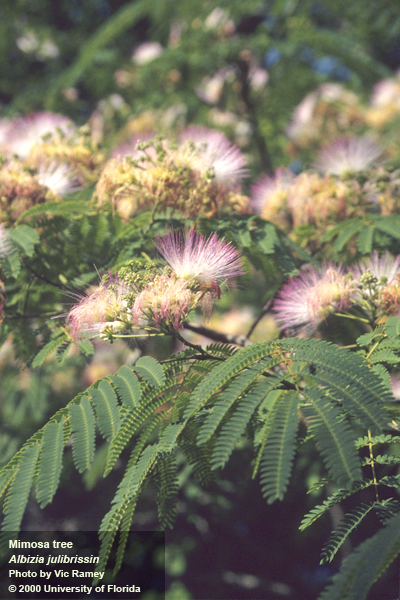Six Rivers “Dirty Dozen” Invasive Species
Mimosa (Albizia julibrissin)
Define Invasive Species: must have all of the following –
- Is non-native to the area, in our case northwest Florida
- Introduced by humans, whether intentional or accidental
- Causing either an environmental or economic problem, possibly both
Define “Dirty Dozen” Species:
These are species that are well established within the CISMA and are considered, by members of the CISMA, to be one of the top 12 worst problems in our area.
Native Range:
Tropical Asia
Introduction:
Intentionally introduced into the United States in 1745 as an ornamental plant. It was popular due to its showy flowers.
EDDMapS currently list 18,546 records of this plant spread across the United States. The vast majority are from the southeastern U.S. 3,323 records are from Florida and 944 within the Six Rivers CISMA. It is most likely under reported.
Description:
This is a small trunked tree with an expanded canopy that reaches about 40 feet in height. It is easily identified by the compounds leaves that can have 20-60 leaflets per branch. The flowers are a brilliant pink and resemble poms-poms. The tree flowers in spring and early summer. Seed pods are present in winter. They are about six inches in length and are light brown in color.
Issues and Impacts:
The primary impact is direct competition with native species. Mimosa does very well in open areas and along the edges of disturbed forested areas. It produces numerous seeds and can take advantage of available native habitats.
Management:
Mechanical removal of saplings is recommended before the plant goes to seed. It is important to remove all roots when pulling by hand to reduce the chance of resprouting.
Chemical treatments (herbicides) will be needed if cutting trees. A 2% solution of glyphosate, or triclopyr, can be used but retreatments may be needed. Application will require a surfactant and contact with the leaves will be enough. 15% Garlon 4, or 100% Pathfinder II, on the bark covering an area of 2 feet can be effective. Trees with trunks larger than 3 inches in diameter may require re-treatment.
There are no known biological controls at this time.
For more information on this Dirty Dozen species, contact your local extension office.
References
Early Detection and Distribution Mapping System (EDDMapS)
Six Rivers CISMA
https://www.floridainvasives.org/sixrivers/
University of Florida IFAS Assessment
https://assessment.ifas.ufl.edu/assessments/albizia-julibrissin/.
University of Florida Center for Aquatic and Invasive Plants
https://plants.ifas.ufl.edu/plant-directory/albizia-julibrissin/.
- Our Environment: Part 10 – Improving Agriculture - June 20, 2025
- Marine Creatures of the Northern Gulf – Snails and Slugs - June 20, 2025
- Our Environment: Part 9 – Agriculture Challenges - June 6, 2025

